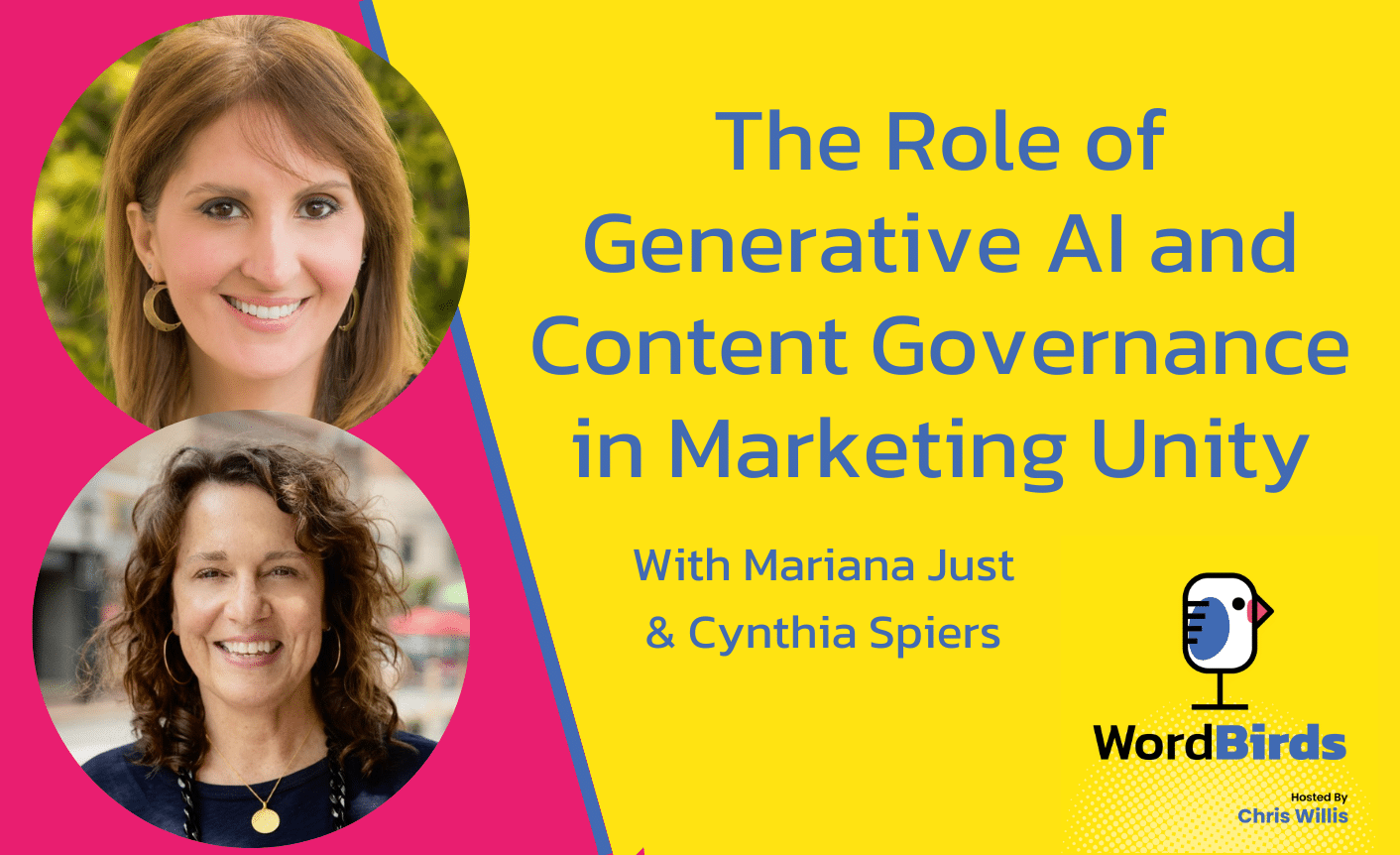The Role of Generative AI and Content Governance in Marketing Unity

This week we have a very exciting episode, featuring not one, but two Vice Presidents from Acrolinx! Mariana Just and Cynthia Spiers are here to talk about why enterprises need to focus on marketing harmony across teams.
How aligned is your marketing department? Content teams and demand generation teams need to be talking to each other. And it has to be more than a content strategy update or sharing the company style guide. At Acrolinx, we believe in marketing unity. Why? Because it drives results.
And with the dawn of generative AI models it’s never been more important to be an aligned marketing organization. Generative AI can generate text and help with publishing content quicker. But without high-quality training data, fine-tuning foundational models, and established editorial guidelines it can pose a major risk.
When it comes to managing content, content governance has never been more important. It’s time to sit back and get some wide ranging insight on AI and content creation from the flock!
Watch the episode
Listen to the episode
Read the full episode transcript
Christopher: Well, hello there. Welcome to the show Marianna and Cynthia!
Mariana: Hey Chris!
Cynthia: Hi Chris, thanks for having us.
Let’s go ahead and jump right into the quick-fire questions. I think that’s a fantastic place to start. I’m going to say a thing and I just want you to say a thing back.
Mariana, amazing content is …
Amazing content powers the customer experience.
Cynthia?
Amazing content is conversational, how we talk to each other. It’s clear, it captures people’s interest, it drives them to want more, and it’s ready to make an impact.
Concise or descriptive?
Concise!
I gotta go with concise. Plain and simple, makes its points clearly, and uses the same voice, which is very important.
Mariana, the company with the best brand voice is …
Other than Acrolinx? I really like Adobe. I think it’s fun, it’s creative, and it’s inclusive. I love Adobe products, so I would say Adobe.
Cynthia?
I’ve gotta go with Mailchimp — before they were acquired. I love it. Casual, smart, concise, and a really relatable voice. They do a great job.
Your best piece of content advice? Let’s start with Cynthia.
I would say never neglect your content and think it doesn’t matter. Because content really drives everything, but more words don’t necessarily make it better, so say what you mean without a lot of fluff. Avoid those empty buzzwords, get rid of the passive voice, just make it really clear, concise, and conversational with a good personality and you’ll be in good shape.
Content isn’t a sales tactic. I think content is education. Content is helping our audience and helping them find what they need. And we got to do that with content before we use it as a selling tactic. Share on XMariana?
Repurpose your content. Plain and simple.
Fantastic. And when I’m creating content I always …
Check it with Acrolinx! Make sure it’s up to your brand and style standards and has all the qualities that you need for it to be amazing.
Good one! I always have my customer in mind when I’m creating content.
Alright, let’s jump into the conversation!
I’m excited to have you both on. An amazing team of “Female Executives of the Year 2022,” both in a very strong marketing organization.
Marianna, tell me a little bit about, well, no, you know what? Let’s go in the supply chain order. Cynthia, tell me a little bit about what you do.
Sure, so I lead a team of four people and one outside web contractor. We have responsibility for content marketing, web and SEO, PR and communications, video, and product marketing. So we wear a ton of hats, but it’s a really talented, collaborative, and dedicated team.
We span several time zones, US, UK, Germany, and Australia. So that actually really helps with the team’s productivity. It’s a bit of a “follow-the-sun” model: when someone’s sleeping, someone else’s always getting work done.
We follow a strategy for all of our respective areas of responsibility. But we make sure that there’s room for flexibility in those strategies because our business moves so quickly and every day is a bit different.

I would say about the team there’s a ton of varied skills, which means we don’t really have to rely that much on outside agencies. We can do a lot of the work ourselves. So, everything from outstanding research and writing skills to video creation, production, design, web content management, SEO, and web analytics. So we’re really covering it all with my team. So it’s great. It’s a very productive, productive, good, and positive experience. And I’ve been here for six years, a little over six years.
Fantastic. I would classify that as the creation aspect of the supply chain, which Mariana, I think would make you the consumption side of the supply chain.
Yes. So I think based on the role, I lead a revenue marketing team and that’s exactly it. Both demand gen marketers and business development reps, which is a little bit unique for some teams. I consistently grew over the last five years into this role, which started with a couple of people on the team and now we’re this global revenue marketing team of six marketers, eight BDRs across the US, England, Germany, and the UAE, as of recently.
We’re 100 percent focused on pipeline creation. So that’s really our North Star. That’s how we’re compensated. And so everything that we do needs to feed into that pipeline machine, which is responsible for the business creation side of Acrolinx.
Computers won’t replace creative humans. Share on XAll of that’s really hard on itself. We’ve got market saturation. We’ve got generative AI now, in ChatGPT. We’re constantly trying to innovate and whether that’s how we think about a new campaign, how we distribute that campaign. We’ve got developing prospecting materials that we need to develop. So there’s a lot that goes into that entire process.
There’s marketing ops, the foundation with reporting and analytics and keeping the pulse check on those pipeline vitals, if you will. So that’s a little bit of the team in a nutshell.
So let’s talk about the interlock here, because we’ve got one organization creating, one organization consuming. You must work together fairly closely to make that go. You’re running a lot of programs. You need a lot of things. How does that work?
Yes, and it’s not just at Acrolinx, right? I have a strong opinion on this that content and demand gen need to really work hand in hand and the teams need to be aligned from a goals and KPIs perspective.
I guess I’ll jump into my provocative thought of the day that there’s no demand gen without content. And so I think one of the biggest mistakes that companies make at times is to try to get the demand gen engine going without prioritizing content. Because content is everywhere!
If you don’t have a demand gen machine, and if you’re just a CEO starting out, you can get content out on a blog, you can be on social media, right? So having those two teams prioritized and working together is quite important in my point of view. But again, I think those common goals need to be very well-defined, and both teams need to have common and measurable goals in place.
But as far as the written word, I think the best performing, most compelling content will always be written by humans. And then there will be efficiency and quality help from AI along the way. Share on XRight now, we’re really focused on customer marketing as a critical initiative. So working with Cynthia and Cynthia’s team very closely on here’s our goals, here’s where we’re going to distribute that content. Because then Cynthia has that intelligence to know, okay, is it free content? We’ll blog about it. Is it premium content? We’ll need to develop a guide for that initiative.
If we’re not working that way, we’re not successful. So that’s my view, Cynthia. I’m not sure how you see that.
I agree Mari. I think shared goals are important for sure. Something that we’ve done more recently that I think has really had a positive impact is that we’ve aligned around thematic content. It used to be that my team would create a lot of content and we’d pass it over to Mari’s team to activate.
And that was working well, but we about a year and a half ago decided that we would start building thematic content quarterly. I think that’s made a positive impact on our ability to unite around that theme. Each quarter we decide what we’re going to be primarily focused on. For example, this quarter, we’re building content that maps to the topic of AI generated content in the enterprise — a hot topic.
Once we’ve settled on that theme, we’re building out that core premium asset. And then around that a complete set of derivative content that’s ready for all the channels that Mariana and team are putting it out into the world. We create a message platform for the demand gen team, so they understand the scope of the topic, how to talk about it, and how to carry it across the buying journey. So in theory, they have everything they need to go and put it out programmatically.
So I think that’s made a big difference in helping us be even more aligned because we all know what we’ve got going on and where we’re focused quarter to quarter. And that really gives, I think, a suite of materials to Mari’s team to be able to activate really effectively.
So Cynthia, it sounds like, based on the requirements, the need, the volume of programs that Marianna’s running, there’s a huge and constant need for creation. You have a relatively lean team. How are you able to keep up with the volume requirements?
Yeah, it’s definitely a small team and we’re able to do it. I have to say, really talented people really help. I’ve got some cracker jack content creators. We don’t rely on a lot of outside content creation.
Everyone at the end of the day in an organization is a writer. Share on XWe also use our own product Acrolinx in this process, which helps us a lot with efficiency. We save a lot of time on editorial. We know that the content we’re producing is up to our brand and style standards because we check it. So we save a lot of time there. And I think that helps with our velocity.
I think doing the theme approach too, we’re all organized quarter to quarter, we know exactly what we need to knock out. And everybody is pulling their weight and getting it done. So that definitely helps with the velocity. But I do think having Acrolinx is really helpful as well.
When you think in terms of the editorial time associated with an individual document in a business, because there’s a writer, there’s a subject matter expert that creates the content, and then it comes to somebody like you that’s going to edit that content. And the editorial process is back and forth between you and that subject matter expert and that could take days, weeks to get that piece of content ready to move forward and then eventually it needs to make it to somebody like me. You know what you run into when you send documents to me.
Pulling back the curtain, everybody, I run this team. I’m the CMO at this company. So it comes to me and I decide, “Hey, this is really neat. Let’s go in a completely different direction.” And now we go back to the subject matter expert and the editorial. And this is a thing. This isn’t an arbitrary example. This happened last week.
What's crucial for us is that we have content governance in place so therefore we can actually use generative AI in a way that feels perhaps a little less risky. Share on XSo days turn into weeks, turn into months, for a single piece of content. Your ability to streamline that editorial process and take the review out of it. Back in the host role, how do you know if your content is good and ready to go to production?
So we set up a benchmark. It needs to score, I like above an 85, but above 80. That’s an Acrolinx Score. That’s what our product assigns to content when it checks it.
What does that mean? What is an Acrolinx Score?
So an Acrolinx Score is a representation of the quality of your content and how aligned it is to the standards that you’ve set as a business. Does it showcase the right tone of voice? Does it include the right terminology? The way your organization talks about its products and services? Does it use inclusive language? Is it scannable?
There’s a whole host of characteristics that we lock in on for our content. We set those standards and then we check it every time we write something to make sure that it’s aligning with those standards. So if it’s an 80 or above, that means it’s doing a fairly good job. As I said, I love it to be even higher, as close as we can get to 100, but there’s no such thing as perfection.

So we do as best we can. And I think it really, it helps me a lot when I see a piece of content if it’s got its Acrolinx Score assigned to it. I know where it stands. That saves me a ton of work. I don’t have to spend as much time if I were just editing something from scratch, we’d get really bogged down in those long editorial cycles.
And back to somebody that works in the business, what I like to say to folks is that you wouldn’t be able to do half the things that you do outside of the content space if you had to do the things that Acrolinx does for you. With the volume of content that you have, you would spend 100 percent of your time involved in editorial.
The fact of the matter is that you don’t, you own the website, you own product marketing, there’s all kinds of things that you’re able to do because your time is cleared up to do those things. If you didn’t have that level of automation and objective scoring, you’d just be a really glorified editor with a VP title, which would be disappointing. You wouldn’t get any of the things that we get.
That would be disappointing. And I’ve worked in organizations like that, where there was an editorial team and every customer facing piece of content had to go through that team and boy, talk about a bog down. I mean, you would wait and wait. Efficiency takes a hit. So, we don’t have that challenge.
I've worked in organizations like that, where there was an editorial team and every customer facing piece of content had to go through that team and boy, talk about a bog down. I mean, you would wait and wait. Efficiency takes a hit. Share on XSometimes we can produce content so quickly, it’s really the design cycle that ends up taking us a little bit more time because we do that externally. So from a production and content creation standpoint, we’re able to do things very quickly.
So that content gets handed over, moves into the demand organization for you. So either that’s a piece of premium content that somebody’s going to download, or it’s the content that fills out a landing page, or it might be email cadences.
Let’s take a dark example. You get this content and you put it out in the world. It’s got an Acrolinx Score, it’s high, it qualifies. You put it out in the world and it doesn’t do what you expect it to do. Mariana, what do you do? How do you optimize for that type of situation?
We go back to the drawing board sometimes. I think one of the things that we do as a demand gen team is we look at other areas that perhaps weren’t as efficient. The channel is one way that we could look back at this. The audience. And did this do what it was meant to do when we talked to Cynthia’s team and brainstormed this whole concept about where it was going to go.
An Acrolinx Score is a representation of the quality of your content and how aligned it is to the standards that you've set as a business. Does it showcase the right tone of voice? Does it include the right terminology? Does it use inclusive language?… Share on XSo there’s recycling of that information, passing it back to the team. We’re very close now with working with our marketing operations team to understand content consumption and give Cynthia’s team visibility into how the content is performing at the point of distribution. Acrolinx does an amazing job of giving us information about how content might perform during the creation process. But we also need to have a very good insight into how it’s performing. So that right now is something we’re very excited to be able to provide to Cynthia’s team and have an understanding of.
We didn’t bring in the MQLs and therefore the meetings that we were expecting, and meet that North Star, which is the pipeline that I was talking about earlier. And that’s okay, because everything is an experiment sometimes. And we know exactly what’s going to work. Sometimes we’ll try something new that doesn’t work, and that is completely fine. We have the reporting capabilities to track that and move quickly and figure that out quickly.
So you’re able to give actionable feedback that you’re finding through consumption back to the content organization versus just saying, “Hey, this stuff doesn’t work.” Like we created it, we think it’s right, we learned from our audience, and we’re aligning better with the audience. You might be able to say it’s audience-aligned content.
It’s a process.
Absolutely. And that’s where the theme is really helpful too, because then we can know too. We’ll develop a theme at a target persona or a group of people and then having that data and that insight from Mariana’s team really helps us to know, “Gee, that’s not as popular of a theme or people aren’t as receptive to that theme as perhaps we thought.”
And again, that’s okay. We go back to the drawing board and we funnel that into our planning and strategy and move on from there. So really helpful to have that kind of closed loop situation going on.
So it would be hard to have a conversation right now, in the world in which we live, without asking about generative AI. Mariana, you have a bunch of BDRs. How is generative AI impacting the BDR outreach process?
It’s certainly making the team more efficient. There’s an opportunity here to do more. This whole concept of being able to rewrite existing content, it’s something that we’re very excited about.
There's no demand generation without content. Share on XWhat’s crucial for us is that we have content governance in place so therefore we can actually use generative AI in a way that feels perhaps a little less risky. The team is extremely excited. Of course it’s all very, very new. For us, we’re taking an approach where we’re working together. We’re not letting people go off and do their own thing on generative AI, we’re having conversations about creative ways to use it. And the team is excited about it.
There’s certainly an opportunity here to make us all very, very, very efficient because everyone at the end of the day in an organization is a writer. But you’ve got to have that alignment with your brand voice and your brand guidelines. Without content governance, you can’t really have that. So I think we’re in an amazing, excellent position to be using generative AI in a way that I don’t think a lot of organizations are in a position to right now.
So what I’m hearing is logging into ChatGPT and saying “Write me an email” is problematic. But being able to leverage content that you know, content that you’ve created, that you’ve essentially governed and created collections around, to be able to be the basis of content creation, that’s the valuable solution.
Just off the shelf, risk of misinformation, disinformation. Feel free to continue my sentences. I’m feeding you words, but is that roughly what y’all are talking about?
Yeah, absolutely. That risk isn’t there anymore. I think for us, that body of content is high quality content based on what Cynthia mentioned earlier, how we score content here at Acrolinx. That body of content that we build through that collection that you just talked about, scores 80 and above. We’re only going to use this content. And that’s an amazing, efficient way to rewrite content.
Fantastic. Cynthia is it playing into what you do at all? You’re the creativity engine. So leveraging generative AI is interesting and efficient to get bulk content out. But do you think that at any point in the near future it’s going to replace the work that your team does from a creative domain expertise standpoint?
Not replace, no. I think it’s definitely an add. It’s an efficiency add. We can ideate. We can generate topic ideas. We can ask ChatGPT, or the like, for creative headlines and that sort of thing. But we’re then having the layer of being able to govern that content through Acrolinx and ensure that it’s time it’s mapped to our standards, which then improves the quality of the collection of content.
content and demand gen need to really work hand in hand and the teams need to be aligned from a goals and KPIs perspective. Share on XThis was going to be my provocative statement, I personally don’t feel like machines will ever take the place of human content creators. I think it can add a lot to the efficiency and the planning and ideation of that content. But as far as the written word, I think the best performing, most compelling content will always be written by humans. And then there will be efficiency and quality help from AI along the way.
I like that PSOTD, not so bad. I mean, this is normally the time when we would break for the PSOTD or Provocative Statement of the Day, but you have both covered those.
We’re ahead of you.
Computers won’t replace creative humans. Really interesting. Mariana, yours was?
I said that there’s no demand gen without content, but I can give you a couple more if you’d like.
Oh, I would like. Throw one at me!
I hate when people say that content marketing is a channel. Content marketing isn’t a channel, people.
Go on.
Oh, why? It fuels the channel, but I don’t think it’s a channel.
What else? Content isn’t a sales tactic. I think content is education. Content is helping our audience and helping them find what they need. And we got to do that with content before we use it as a selling tactic.
Fantastic. Ladies, thank you very much for being on the show! I would say I’d love to have you back sometime, but I see both of you every single day. So we’ll probably do this again in the near future. Thank you very much.
Thanks for having us.
Thank you, Chris.
Important links
- Mariana Just – LinkedIn
- Cynthia Spiers – LinkedIn
- Acrolinx
- WordBirds – LinkedIn
- WordBirds – Home page
Are you ready to create more content faster?
Schedule a demo to see how content governance and AI guardrails will drastically improve content quality, compliance, and efficiency.

Charlotte Baxter-Read
is a Communications and Content Manager at Acrolinx, bringing over three years of experience in content creation, strategic communications, and public relations. Additionally, Charlotte is the Executive Producer of the WordBirds podcast — sponsored by Acrolinx. She holds a Master’s degree from the John F. Kennedy Institute, at Freie Universität Berlin, and a Bachelor's degree from Royal Holloway, University of London. Charlotte, along with the Acrolinx Marketing Team, won a Silver Stevie Award at the 18th Annual International Business Awards® for Marketing Department of the Year. She's a passionate reader, communicator, and avid traveler in her free time.




